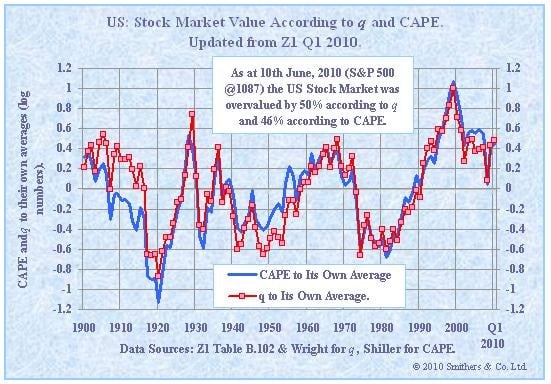John Hussman on Taxes and Tobin’s Q-Ratio
John Hussman is out with his latest weekly commentary. He continues to make good points about the market’s overvaluation despite the forward earnings crowd’s cries that P/E ratios (see Hussman: US shares are 40% overvalued). While Comstock Partners made a number of the points I highlighted in the last Hussman-based post regarding the inappropriateness of forward earnings multiples in their post Valuations, Hussman this time reaches into Tobin’s tool box for the Q-ratio as well:
I can’t emphasize enough that when you hear an analyst say "stocks are cheap based on forward operating earnings" it would be best to replace that phrase in your head with "stocks are cheap based on Wall Street’s extrapolative estimates of a misleading number."
More sober and historically reliable measures of market valuation create a much more challenging picture. Apart from our own measures, which indicate continued overvaluation, there are several good indicators of market valuation that are not overly sensitive to year-to-year fluctuations in profit margins. One is based on the 10-year average of actual net (not operating) earnings, which is advocated by economist Robert Shiller, and another is Tobin’s "q" ratio which is based on comparing market value to replacement cost, and is advocated by Andrew Smithers. Both of these measures largely agree with our own measures, both presently and on a historical basis. Based on last week’s valuations, both suggest that the S&P 500 is substantially overvalued.
Switching gears for a second, I also ran across this blurb in John Hussman’s latest weekly letter. He talks about tax policy in ways I agree with.
Republicans are pushing for an extension of the Bush tax cuts using supply side economic arguments that are patently false. Former Reagan domestic policy advisor Bruce Bartlett did a good job of debunking this in his piece Republican Tax Nonsense. Moreover, these tax cuts increased tax variability creating a perfect opportunity for the kind of tax arbitrage that the wealthy can play which workers who earn the vast majority of income from labour cannot.
What should we do on taxes then? What Hussman suggests harmonizing tax rates across all of the different forms of income to reduce the opportunity for arbitrage. To make tax rates progressive he recommends increasing the exclusion so that workers making the least pay a lower mean tax rate even though their marginal rate is the same. This is what I would propose as well. I would also close as many loopholes as possible. The net result would be more simpler and more equitable.
Economic Policy Notes
The U.S. economy continues to face the predictable effects of credit obligations that quite simply exceed the cash flows available to service them, coupled with the predictable shift away from the consumption patterns that produced these obligations. The misguided response of our policy makers has been to defend bondholders at all costs, using public funds to make sure that lenders get 100 cents on the dollar, plus interest, while at the same time desperately trying to prod consumers back to their former patterns of overconsumption. These policies are designed to preserve exactly the reckless and unsustainable behavior that caused the recent downturn. They are likely to fail because the strategy is absurd. The ultimate outcome, which will be forced upon us eventually if we do not pursue it deliberately, will be the eventual restructuring of debt obligations and a gradual shift in the profile of U.S. economic activity toward greater saving – either to finance exploding government deficits, or preferably, to finance an expansion in productive investment, research and development, and capital accumulation.
From my perspective, bolder approaches are required. Debt that cannot be serviced should be restructured, rather than socializing the losses of reckless private decision-making. We will inevitably have a large "stimulus" package, but it will be essential to craft it in a way that emphasizes incentives to create and accumulate productive capital, both private and public.
On the tax side, we also have options. There are far more possibilities than simply preserving or discarding the Bush tax cuts. Frankly, I was never a fan of those cuts, which added more variation, not less, in tax rates across various forms of income. Ideally, efficient tax systems should feature flat rates and very broad bases. You define income in a very wide manner, and you tax it all at the same rate. You introduce a progressive tax structure by creating large exclusions from taxes at low income levels, so that people at lower income scales pay no tax at all. In my view, the same thing should be done with Social Security – drop the rate substantially, but include all income – wage and non-wage. Three-quarters of Americans pay more in payroll taxes than in income taxes. By reducing the wedge between the hourly amount earned by employees and the hourly cost paid by employers, this strategy would create immediate incentives for employment. Moreover, it would raise more revenue because at present, even Warren Buffett only pays Social Security taxes on the first $106,800 of income. Combining a flatter income tax with a flatter and broader payroll tax would stimulate growth, employment, and greater economic efficiency without compromising total revenues.
Great read. Look for the parts on the divergence between trailing S&P500 earnings and NIPA profits. His comments are not what I expected.
Source: Don’t Take the Bait – John Hussman

Comments are closed.